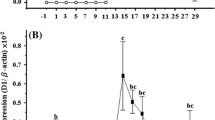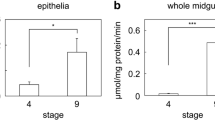Summary
Analysis of factors influencing survival of tail tips ofXenopus larvae “in vitro” has shown that prevention of infection by antibiotic pretreatment of donor tadpoles and amputated tips is most critical. In tail tips exceeding not more than 1/3 of the body length, maintenance of N-content and regenerative capacity are superior in Niu-Twitty and Steinberg's saline than in Holtfreter's solution, all media being supplemented by 0.04 % sulfathiazole. Addition of nutrient ingredients to saline (glucose, Parker's medium 199, serum protein) does not improve viability of tail explants.
In isolated tail tips 2.5×10−7M L-thyroxine (T4) induces involution “in vitro”, resulting in losses of about 85% in DNA and 70% of protein respectively after 12 days of treatment. A significant decrease in DNA occurs after three days, and for protein after 6 days of hormone treatment, when tail fins are almost fully resorbed.
Statistical analysis of the regression curves for decrease in DNA and protein, produced by different concentrations of T4, indicates the presence of an upper threshold (2.5×10−7M) and a lower threshold (2.5×10−8M) of sensitivity to hormone. Intermediate concentrations affect the latency time required for onset of DNA and protein loss, lengthening it at lower concentration.
In tail tips exposed to 2.5×10−7M T4 a concurrent rise in activity of cathepsins, DNase and acid phosphatase has been demonstrated. The specific activities of these acid hydrolases are significantly higher in T4-treated tails after four days of hormone administration, this response proceeding detectable loss in protein by two days. Extent and duration in the rise of activity are characteristic for each enzyme, the increase in both specific and total activities being highest for cathepsins, intermediate for DNase and lowest for acid phosphatase.
Zusammenfassung
Die Untersuchung der für das Überleben von isolierten Schwanzspitzen vonXenopus-Larven wesentlichen Kulturbedingungen hat ergeben, daß die Verhütung von Infektionen durch Vorbehandlung der Kaulquappen und der amputierten Schwanzspitzen für den Erfolg entscheidend ist. Schwanzspitzen, deren Länge 1/3 der Körperlänge der Kaulquappen nicht überschreitet, zeigen einen geringeren Verlust an N-haltigen Stoffen und ein besseres Regenerationsvermögen in Niu-Twitty- und Steinberglösung gegenüber der Lösung nach Holtfreter, obwohl alle Medien 0,04% Sulfathiazol enthalten. Zusatz von Nährstoffen (Glucose, Parker's Medium 199, Serumprotein) ergeben keine Verbesserung der Überlebensfähigkeit.
In isolierten Schwanzspitzen bewirken 2,5×10−7M L-Thyroxin (T4) die Rückbildung „in vitro“, wobei im Verlaufe von 12 Tagen der DNS-Gehalt um 85% und derjenige an Protein um 70% sinkt. Der DNS-Verlust ist bereits nach 3 Tagen signifikant, während eine signifikante Abnahme an Protein erst nach 6 Tagen Hormonbehandlung nachgewiesen werden kann, wenn die Flossensäume bereits resorbiert sind.
Aufgrund der statistischen Analyse der für den DNS- und Proteinverlust in Abhängigkeit von verschiedenen T4-Konzentrationen ermittelten Regressionsgeraden ergeben sich folgende Aussagen: 2,5×10−7 M repräsentiert die obere und 2,5×10−8 M T4 die untere Empfindlichkeitsschwelle. Innerhalb dieses Bereiches zeigt die Latenzzeit für den Beginn der DNS -und Proteinabnahme, nicht aber die Geschwindigkeit des Involutionsprozesses eine Konzentrationsabhängigkeit, indem die Latenzzeit mit fallender T4-Konzentration zunimmt.
Unter der Einwirkung von 2,5×10−7 M T4 nimmt in den Schwanzspitzen die Aktivität von Kathepsinen, DNase und saurer Phosphatase gleichzeitig zu. Die spezifische Aktivität dieser sauren Hydrolasen ist bereits nach 4 Tagen Hormonbehandlung signifikant erhöht, während ein signifikanter Proteinverlust erst am 6. Tag der Behandlung nachgewiesen werden kann. Ausmaß und Dauer der Aktivitätszunahme sind für jedes Enzym charakteristisch; die Zunahme der spezifischen und Gesamtaktivität ist am größten bei den Kathepsinen, etwas geringer bei der DNase und am niedrigsten bei der sauren Phosphatase.
Similar content being viewed by others
References
Boell, E. J., Shen, S. C.: An improved ultramicro-Kjeldahl technique. Exp. Cell Res.7, 147–152 (1954).
Coleman, J. R.: Deoxyribonuclease activity in the development of the leopard frog,Rana pipiens. Develop. Biol.5, 232–251 (1962).
Deken-Grenson, M. de, Deken, R. H. de: Elimination of substances interfering with nucleic acids determination. Biochim. biophys. Acta (Amst.)31, 195–207 (1959).
Derby, A.: An “in vitro” quantitative analysis of the response of tadpole tissue to thyroxine. J. exp. Zool.568, 147–156 (1968).
—, Etkin, W.: Thyroxine induced tail resorption “in vitro” as affected by anterior pituitary hormones. J. exp. Zool.169, 1–8 (1968).
Eeckhout, Y.: Contribution à l'étude de la métamorphose caudale des amphibiens anoures. Thèse, Univ. Catholique de Louvain (1965).
—: Etude biochimique de la métamorphose caudale des amphibiens anoures. Mém. Acad. roy. Méd. Belg.38, 1–113 (1969).
Etkin, W.: Metamorphosis. In: The physiology of the amphibia (J. A. Moore, ed.), p. 427–468. New York: Academic Press 1964.
—: Hormonal control of amphibian metamorphosis. In: Metamorphosis: A problem in developmental biology (W. Etkin, L. I. Gilbert, eds.), p. 313–348. New York: Appleton-Century Crofts 1968.
Fell, H. B., Dingle, J. T.: Studies on the mode of action of vitamin A. 6. Lysosomal protease and the degradation of cartilage matrix. Biochem. J.87, 403–408 (1963).
Flickinger, R. A.: A study of the metabolism of amphibian neural crest cells during their migration and pigmentation “in vitro”. J. exp. Zool.112, 465–484 (1949).
—: Iodine metabolism in thyroidectomised frog larvae. Gen. comp. Endocr.3, 606–615 (1963).
Giles, K. W., Myers, A.: An improved method for estimation of DNA. Nature (Lond.)206, 93 (1964).
Gross, J., Lapière, Ch. M.: Collagenolytic activity in amphibian tissues: A tissue culture assay. Proc. nat. Acad. Sci. (Wash.)48, 1014–1022 (1962).
Hauser, R.: Autonome Regenerationsleistungen des larvalen Schwanzes vonXenopus laevis und ihre Abhängigkeit vom Zentralnervensystem. Wilhelm Roux' Arch. Entwickl.-Mech. Org.156, 404–448 (1965).
—, Lehmann, F. E.: Regeneration in isolated tails ofXenopus larvae. Experientia (Basel)18, 83 (1962).
Holtfreter, J.: Über die Aufzucht isolierter Teile des Amphibienkeimes. Wilhelm Roux' Arch. Entwickl.-Mech. Org.124, 404–466 (1931).
Jones, K. W., Elsdale, T. R.: The culture of small aggregates of amphibian embryo cells “in vitro”. J. Embryol. exp. Morph.11, 135–154 (1963).
Kaltenbach, J. C.: Nature of hormone action in amphibian metamorphosis. In: Metamorphosis: A problem in developmental biology (W. Etkin, L. I. Gilbert, eds.), p. 399–441. New York: Appleton-Century Crofts 1968.
Kollros, J. J.: Mechanisms of amphibian metamorphosis: Hormones. Amer. Zool.1, 107–114 (1961).
Lindsay, R. H., Buettner, L., Wimberly, N., Pittman, J. A.: Effects of thyroxine analogs on isolated tadpole tail-tips. Gen. comp. Endocr.9, 416–421 (1967).
Lowry, O. H., Rosenbrough, N. J., Farr, A. L., Randall, R. J.: Protein measurement with the Folin phenol reagent. J. biol. Chem.193, 265–275 (1951).
Moser, H.: Ein Beitrag zur Analyse der Thyroxinwirkung im Kaulquappenversuch und zur Frage nach dem Zustandekommen der Frühbereitschaft des Metamorphose-Reaktionssystems. Rev. suisse Zool.57, Suppl. 2, 1–144 (1950).
Moser, H., Hadji-Azimi, I., Slatkine, S.: Culture of cells derived from the South African frogXenopus laevis (Daudin). Rev. suisse Zool.75, 619–630 (1968).
Nieuwkoop, P. D., Faber, J.: Normal Table ofXenopus laevis (Daudin). Amsterdam: North Holland Publ. Co. 1956.
Salzmann, R., Weber, R.: Histochemical localization of acid phosphatase and cathepsin-like activities in regressing tails ofXenopus larvae at metamorphosis. Experientia (Basel)19, 352–354 (1963).
Shaffer, B. M.: Demonstration. 9th Intern. Congr. Cell Biol., St. Andrews (Fife) (1957).
—: The isolatedXenopus laevis tail: A preparation for studying the central nervous system and metamorphosis in culture. J. Embryol. exp. Morph.11, 77–90 (1963).
Silbert, J. E., Nagai, Y., Gross, J.: Hyaluronidase from tadpole tissue. J. biol. Chem.240, 1509–1511 (1965).
Stefanelli, A., Thermes, G., Massidda, R.: Fenomeni regenerativi e degenerativi nelle code isolate diHyla arborea (Savinji). Rend. Sem. Fac. Sci. Univ. Cagliari20, 1–7 (1950).
Tata, J. R.: Requirement for RNA and protein synthesis for induced regression of the tadpole tail in organ culture. Develop. Biol.13, 77–94 (1966).
Vaes, G.: La résorption osseuse et l'hormone parathyroidienne. Bruxelles: A de Visscher; Paris: Maloine 1966.
Vulpian, M.: Note sur les phénomènes du développement qui se manifestent dans la queue des très jeunes embryos de grenouille après qu'on l'a séparée du corps par une section transversale. C.R. Acad. Sci. (Paris)48, 207 (1859).
Weber, R.: Induced metamorphosis in isolated tails ofXenopus larvae. Experientia (Basel)18, 84 (1962).
—: Behaviour and properties of acid hydrolases in regressing tails of tadpoles during spontaneous and induced metamorphosis “in vitro”. In: Ciba Found. Symp. Lysosomes (A.V.S. de Reuck, M. P. Cameron, eds.), p. 282–300. London: Churchill Ltd 1963a.
—: Zur Aktivierung der Kathepsine in Schwanzgewebe vonXenopuslarven bei spontaner und “in vitro” induzierter Rückbildung. Helv. physiol. pharmacol. Acta21, 277–291 (1963b).
—: Über den Wirkungsmechanismus des Thyroxins in der Metamorphose der Amphibien. Rev. suisse Zool.73, 559–567 (1966).
—: The biochemistry of amphibian metamorphosis. In: The biochemistry of animal development (R. Weber, ed.), vol. II, p. 227–301. New York: Academic Press 1967.
—: The isolated tadpole tail as a model system for studies on the mechanism of hormonedependent tissue involution. Gen. comp. Endocr., Suppl.2, 408–416 (1969a).
—: Tissue involution and lysosomal enzymes during anuran metamorphosis. In: Lysosomes in biology and pathology (J. T. Dingle, H. B. Fell, eds.), vol. 2, p. 437–461. Amsterdam: North-Holland Publ. Co. 1969b.
Wilde, C.: Studies on the organogenesis “in vitro” of the urodele limb bud. J. Morph.86, 73–114 (1950).
Author information
Authors and Affiliations
Additional information
These studies were carried out within the scope of a project supported by the “Schweizerischer Nationalfonds zur Förderung der wissenschaftlichen Forschung” under the direction of Prof. B. Weber.
The author would like to acknowledge the advice and encouragement of Prof. R. Weber in all phases of these studies, and the assistance of Prof. S. Rosin with the statistical techniques. Further, the technical assistance of Miss A. Rohner, Miss B. Fahrer, Mr. J. Zbären, and Mr. T. Wyler is gratefully acknowledged.
Rights and permissions
About this article
Cite this article
Hickey, E.D. Behaviour of DNA, protein and acid hydrolases in response to thyroxine in isolated tail tips ofXenopus-larvae. W. Roux' Archiv f. Entwicklungsmechanik 166, 303–330 (1971). https://doi.org/10.1007/BF00584821
Received:
Issue Date:
DOI: https://doi.org/10.1007/BF00584821




